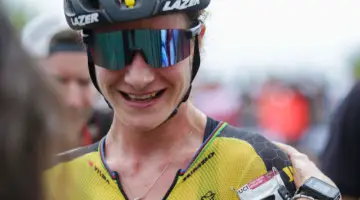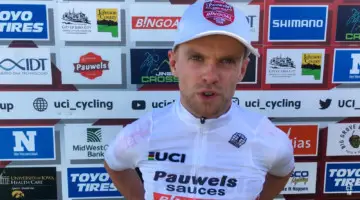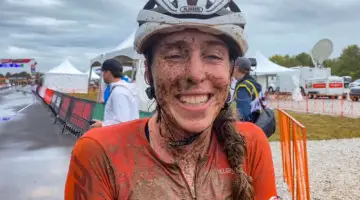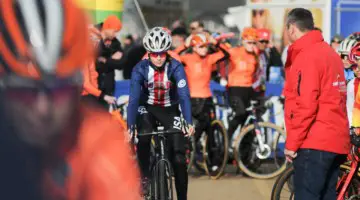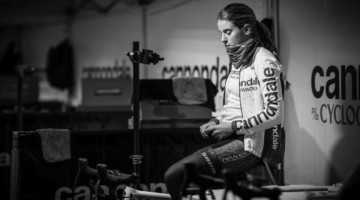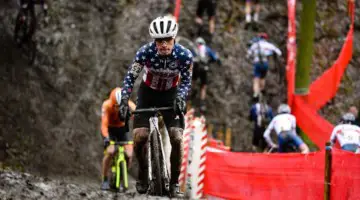Even if you do not know the name Bruce Buckley, if you are a consumer of cyclocross media, chances are good you are familiar with his photography.
Buckley’s friends have jokingly given him the moniker “The Official Photographer of North American Cyclocross.” Fun yes, but also kind of true.
A professional photographer by trade, Buckley got into cyclocross racing over a decade ago and then started bringing his camera with to races. Some work for national publications turned into a partnership with fellow D.C. area media person Bill Schieken of CXHairs turned into work for national teams and events.
Buckley now travels to UCI races across the country and is a photographer for teams such as Kona Maxxis Shimano and Donnelly / Aevolo as well as races such as DCCX and GO Cross.
“Bill is incredibly driven and passionate, and he’ll do what it takes to be where he needs to be to get the job done. He was really kind of encouraging me to get myself out there and go to CrossVegas and go to all these big races that were starting to happen. That’s how I really got things in motion,” Buckley said.
“After that, it’s been a long evolution for me. It’s been a long time of me just shooting cyclocross, meeting people, forging relationships, and over time, it has led to opportunities and then other opportunities and now here I am today.”
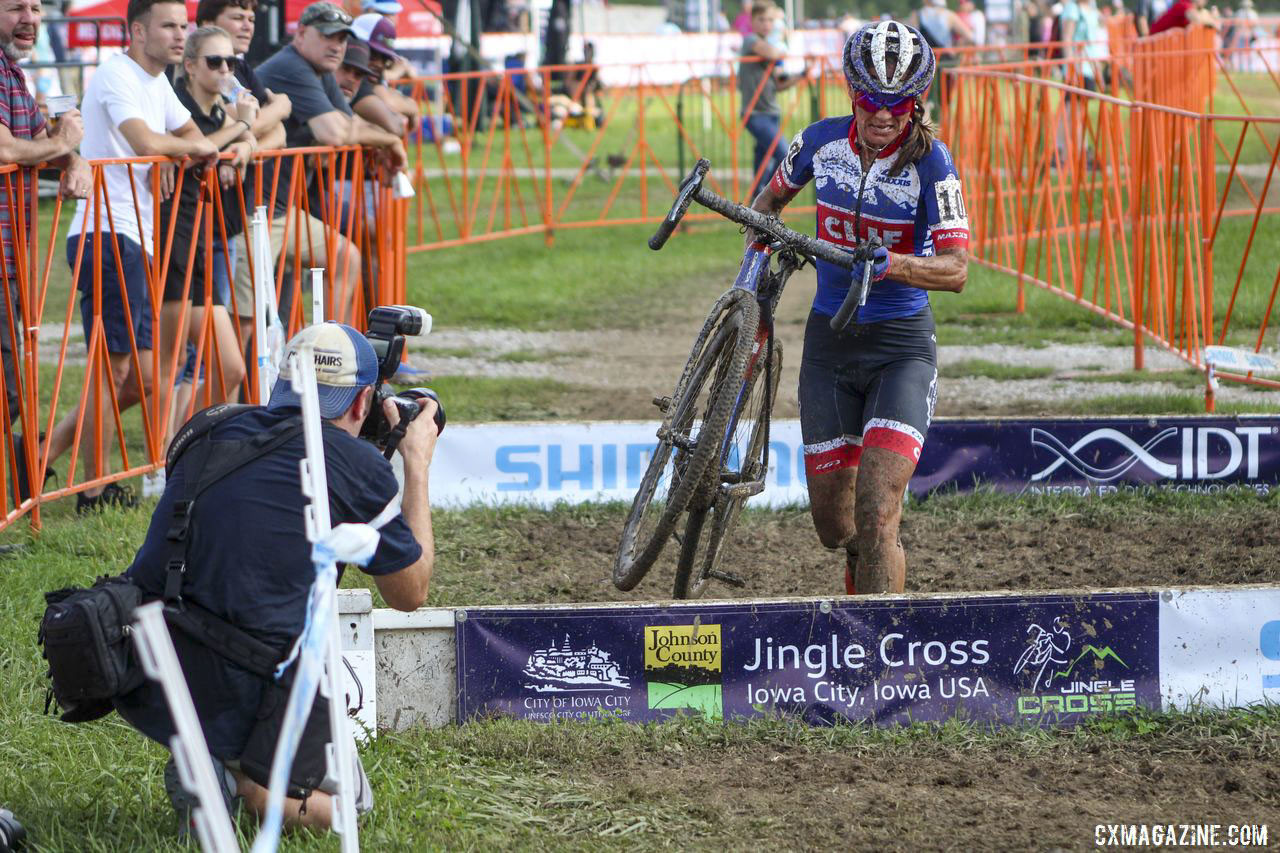
Bruce Buckley wears his Crosshairs hat to this day to pay homage to his start as a cyclocross photographer. © Z. Schuster / Cyclocross Magazine
As someone who dabbles in ’cross photography, I was excited to restart our behind-the-scenes series and talk with Buckley about his craft. You can read a transcript of our conversation below.
For more looks at the folks who help make cyclocross go, see my interviews with announcer Scot Herrmann, Team S&M CX manager and mechanic Brenna Wrye-Simpson and race director John Meehan.
Interview: Bruce Buckley, the Official Photographer of American Cyclocross
Cyclocross Magazine: How did you get into photography? Is this a life-long thing? Is it something you did in college?
Bruce Buckley: It depends on what you mean by how I got into photography. I started shooting photographs when I was in high school, probably. My dad had a lot of photo gear around. He was a photographer as part of his job. He had just thousands of photos in the house. I was kind of surrounded by it growing up.
After I graduated from high school, I went and lived in Europe for a year, and I got a camera before I went. I spent a whole lot of time taking a whole lot of pictures when I was in Europe. That really solidified my growing interest in it.
I came home and went to college, and I went to journalism school and studied print journalism as well as photojournalism. That really started me on this path to where I am now.
CXM: Most people involved in cyclocross behind the scenes aren’t necessarily making the big bucks, what do you do during the week to tide you over and make sure you can contribute to the cyclocross community?
BB: I’m a full-time photographer. During the week, I’ll shoot a whole variety of stuff. I have quite a few corporate clients. That can also include some portrait work. Some architectural-related work.
Events, I shoot a bunch of events for clients during the week. It could be a corporate event or like a neighborhood event. I work for some local business districts in the D.C. area. They’ll have events, and I’ll shoot those for them.
There is really a wide mix of stuff I do. I know a lot of people push for specialization in photography, and I would say my specialty, in terms of what I’m known for, is my sports work. I think in today’s economy, if you want to be a full-time photographer, you need to be able to shoot whatever needs to be shot.
CXM: So you are the Official Photographer of American Cyclocross now. What’s your background in cyclocross? Do you race? How did you specifically get into cyclocross?
BB: I did my first bike race when I was a Junior. I was initially into road bikes. Actually, I was initially into BMX bikes, but that wasn’t racing. I never raced BMX. Then I got a road bike and got into that. Those were the first races I ever did. Then I went to college and forgot about bikes for a while.
After graduating, I got into mountain bikes and raced there for a long time. I found I couldn’t really train consistently just on a mountain bike without it completely beating me up. If you want to train day after day, it can be pretty hard. I was riding on the road on a mountain bike, so I just kind of naturally transitioned to road again. I guess I had enough fitness from mountain bikes, I kind of had a head start for that. I won some races early and got the road bug for a while. Until I stopped winning races.
CXM: It happens to all of us.
BB: It was the typical thing where you hit Cat 3, and you’re like, ‘This is getting pretty hard guys.’
CXM: For sure.
BB: I had a friend who got me into cyclocross while I was racing on the road. It was a nice way to have something to do when road season cooled off. I was just bitten by that bug immediately. I loved it.
I had already had that mountain bike background, and maybe even some BMX skills from my childhood, so I liked that bit about being off-road mixed with the strategy of road racing. It was all these things I liked in one sport. Then the community was what really made me fall in love with it.
CXM: How long ago was that?
BB: I’d say that was like 2005 or 2006?
CXM: You’ve been at it for a while.
BB: Well, I haven’t raced in a while either. I stopped racing a few years ago. I raced for a solid decade there.
CXM: You have the photography background and the love of the sport, and it seems like you’ve hitten the national scene thanks in part to your work with Bill Schieken at CXHairs. How did you go from a dude with a camera at some local races to someone who is covering World Cups?
BB: One-hundred percent, that’s who I was. I worked for a local sports magazine and was shooting for them. But that wasn’t just cyclocross. I was shooting that, and digital cameras were starting to get a lot better. Being able to shoot sports with a digital camera became way more accessible.
I just started bringing my camera to races. Over time I was expanding out the amount of time I was spending at races. Eventually I was getting there for the first race, shooting everything I could, putting the camera away and racing and then picking up the camera again.
CXM: Probably not racing quite as well as that went on, correct?
BB: Yeah, I think that’s part of that decline. I was running around and doing all this stuff and then trying to race. But I loved it. I just got totally bitten by that bug, and I just wanted more of it. I was spending both days of the weekend living cyclocross.
Following up on the local sports work I had done, I was able to pick up some local races for national publications, like VeloNews ran some of my stuff back in 2009 or 2010. We had some good races in the Mid-Atlantic that the national publications would want to cover.
But probably a lot of it started to accelerate when I started connecting with this guy who I used to race a lot with named Bill Schieken. We both raced here locally in the same category. I raced elbows out against him like every weekend. It’s funny because we were evenly matched at that time.
The real change came when Bill started to work on his training book project, Skills, Drills and Bellyaches. I think we were talking about that project all the way back in 2011. It grew and grew and it took a long time for it really to all come together. We worked on it for a while, and it eventually got to the point where Jeremy Powers was on board. I got to photograph Jeremy showing all the skills.
That sort of forged that relationship with Bill that I had and still have today. I would say that helped take things to a more national stage. Bill is incredibly driven and passionate, and he’ll do what it takes to be where he needs to be to get the job done. He was really kind of encouraging me to get myself out there and go to CrossVegas and go to all these big races that were starting to happen. That’s how I really got things in motion.
After that, it’s been a long evolution for me. It’s been a long time of me just shooting cyclocross, meeting people, forging relationships, and over time, it has led to opportunities and then other opportunities and now here I am today.
CXM: One thing that was interesting about talking to Scot Herrmann, he’s someone who has really worked his butt off over the years. It didn’t happen overnight. Did you ever have a sense of where you wanted to end up?
BB: It’s funny because I am a planner. Ask Bill, I am a really intense planner on a project basis, but in the grand scheme of things, I have really kind of gone with the flow. What I ended up finding was it felt better and more natural and more authentic to let it grow organically where it was like meet somebody, meet another person, build a relationship, start shooting for them, start shooting for someone else. Let it go where it wanted to go.
Some people have this vision of the end first, and I wasn’t willing to do that. I didn’t want to say, ‘This is what I’m going to be.’ I wanted to let this grow naturally into what it’s supposed to be.
CXM: I hear you, I think I’m kind of the same way. Although there are some people who might say, ‘I want to be the official photographer of American cyclocross.’ I know that annoys you, so I’m going to keep saying it.
BB: You can have it. I have never claimed that title on my own. That’s mostly Bill trolling me. And you, by the way. I know you jump in on that too.
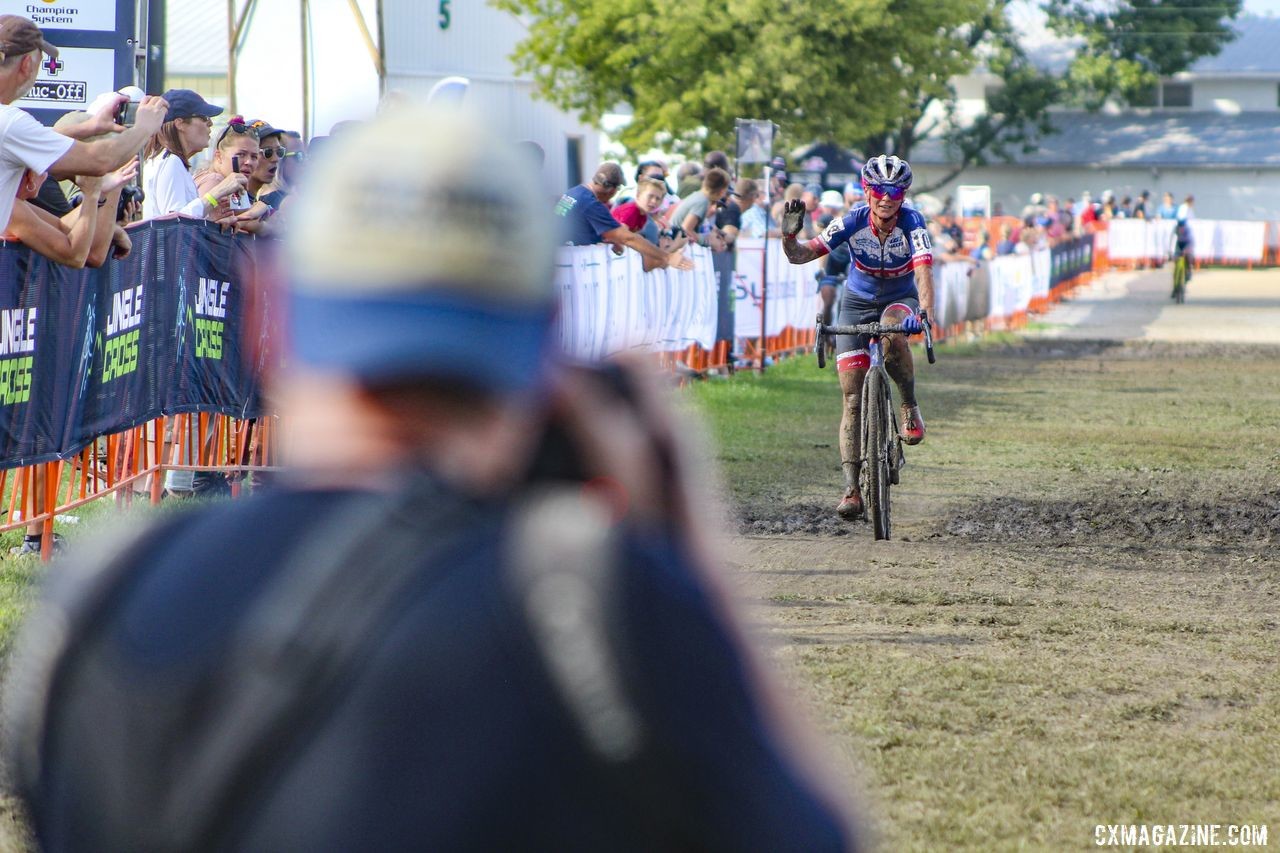
Bruce Buckley has slowly built up to where he’s at. © Z. Schuster / Cyclocross Magazine
CXM: The latest incarnation of what you’re doing seems to be shooting for teams. Is that what it’s morphed into and how has that been for you taking on some team contract work?
BB: I still do a mix of things. I still do some promoter work. Like when I was at GO Cross, I was actually working for GO Cross in addition to my other work. That’s one example. I’ll still do editorial work as requested. I’ll be doing a few things with that this year.
There’s still that, but I would say on the regular, I am looking at a lot of work for teams. That’s different, but it’s really interesting. I’ve really come to enjoy that kind of work. You get to know your subject on a much deeper level, and its very meaningful work in a lot of ways because you kind of see what goes on in the background. You see not just what people put out there on the course, you see them as individuals. You see what they are doing to get ready to put themselves out onto the course. What it takes to race at the highest level.
You get to see some of their personalities come out. Not just the race-day game face. Nobody walks through life like that all the time. That’s been really interesting. The journalism side of me enjoys that because it’s a type of in-depth storytelling in a sense.
CXM: Moving into the nitty-gritty a little bit, if you’re working for a team, how do you plan out what they’re looking for and what you’re looking for? How do you look at approaching a coming race weekend?
BB: Just today, I reached out to someone from a team I’m shooting for, this is someone I’ve worked for in the past, so we know each other, at this point I can go in and say, ‘Do you want me to go in and do my usual work? Do you want something different?’ At the beginning of the season, there might be something that needs to be done like a profile pic or a rider with their new bike. I always ask if there are some kinds of special requests.
To back things up a little, my career path doesn’t go this way, but as far as events go, I am all about planning. My whole motto is ‘Plan, plan, plan, and when none of that works out, improvise.’
As I go into an event, I’m thinking, ‘Okay, who am I shooting for? Which teams am I shooting for?’ Sometimes it’s one team, but sometimes I might have like six clients at an event. Then what kind of content am I shooting? I’ll reach out and ask what they’re looking for. If I can get a shot list, that’s great, but maybe it’s just exchanging some emails or having a conversation and we’ll come up with something.
So days out, I’m starting to look at weather forecasts, and I’m thinking about how that could factor into what I’m doing. That could be in part a gear question but in part a content question as well.
I put a lot of emphasis on scouting before an event. I will try to get to a venue, if possible, the day before to scout some locations where I might shoot. Then the big part of it for me is figuring out all the logistics of getting around the course. Then I kind of run a little logistics plan where I’m saying, ‘Okay, if I shoot here and then I want to shoot there, how long will it take and do I think I’ll get there before the leaders get to that point.’ I run a full logistics plan. It’s a lot about timing and routes and thinking about course crossings and spectators or cars or tents that might be in the way.
I try to do that the day before, but if I can’t, I’ll come to the venue on the day of the first race and I’ll get there as early as possible and I’ll start scouting in the morning.
Then the night before, I need to make sure everything is ready so I can just walk out the door. I clean all my optics and make sure my batteries are charged. Make sure my memory cards are cleared and formatted. Then I get everything packed. I don’t want to be spending three hours in the morning getting out the door. That never works well.
Not being prepared makes you scramble. I want to do anything I can to not feel rushed and scrambled. This is part of the reason why I scout; so I feel more relaxed. I have my gear ready to go, I have my plan in place and I’m not stressed. It sort of relaxes your mind before you go to do all the work. The work can be really chaotic on its own, so you don’t want to start stressed.
The day of the first race, I might pick an amateur field to shoot just to make sure the plan works. Before I’m just guessing, but that gives me a chance to see how it works at speed. Maybe not pro speed, but it still helps me figure it out.
If I’m working for teams, or even if I’m not working for teams, I’m going around and just trying to get colorful shots around the venue or racers in their tents pre-race. Maybe they’re warming up or hanging out. I did a lot of that with Donnelly with Laurel and Lance. They were awesome. They were just so much fun to see behind the scenes. That’s one example.
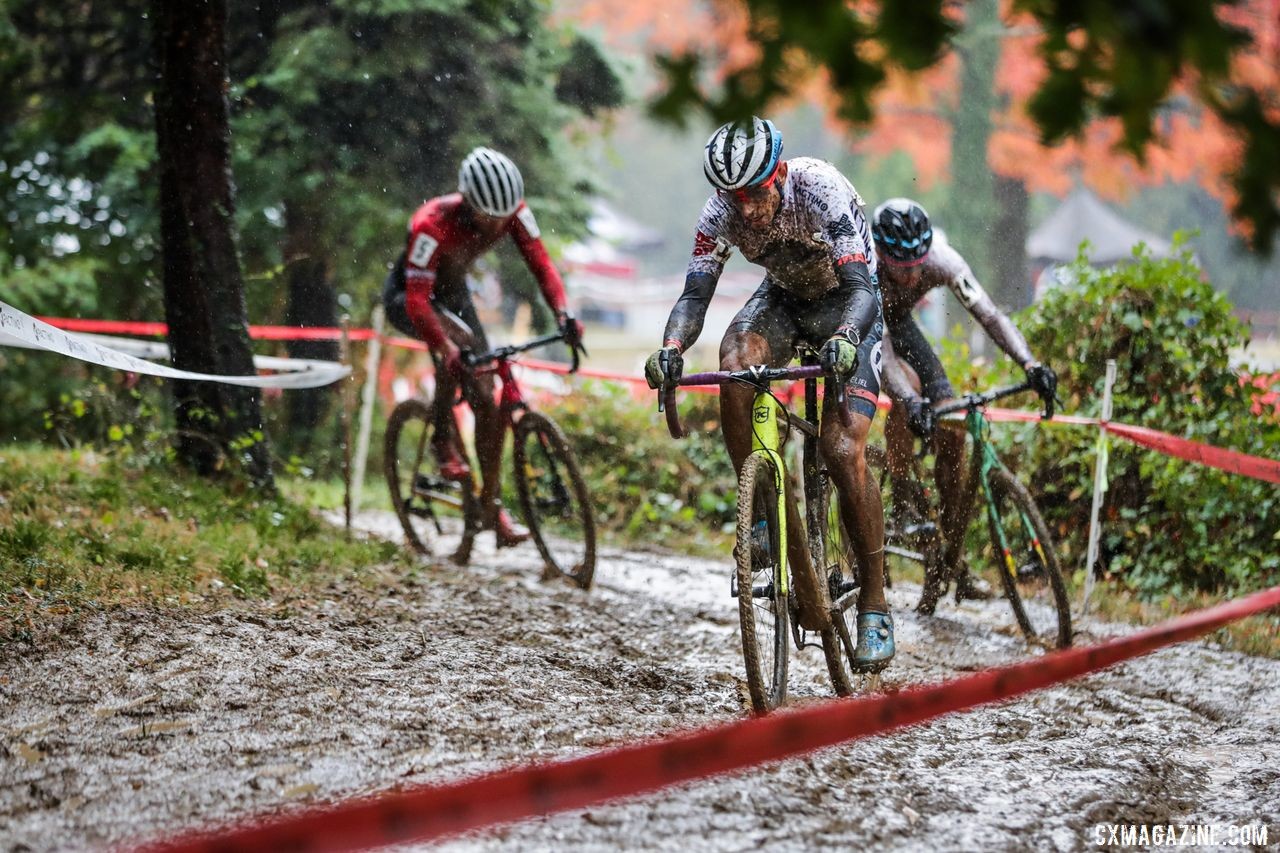
Bruce Buckley did editorial work for DCCX this season. 2019 DCCX Day 2. © Bruce Buckley
CXM: Can I interrupt for a minute? Is that okay?
BB: I think you’re allowed to do that.
CXM: Okay, let’s do it. Hit me with one or two courses that you really enjoyed shooting. Like, what makes a good photographer’s course?
BB: Oh man, there are two ways to look at that and they are polar opposites of each other. One is ease of access. I would say GO Cross does it well. They do it two different course configurations and one of those configurations, I can get shots five times in one lap.
CXM: Oooo, that’s nice.
BB: The access is quite easy. I can get tons of shots there, and that makes my job much easier. The way I approach things, I try to follow an 80/20 rule where I am going to spend 80% of my time trying to really nail the must-haves, and then 20% is trying some things out. Getting creative and going off-plan and saying, ‘I am going to just enjoy being a photographer for a moment.’ On a course like that where I can get so many shots per lap, that just opens me up to being able to try a whole range of different things. So in a sense, that’s a really great course.
But then, sometimes, the hardest courses end up being some of the most rewarding courses. They’re really hard to get around, but they just deliver great results. For example, Jingle Cross. That place in phenomenal. For American cyclocross, that place has so many iconic features.
CXM: Well, we all know if you don’t get the foreground Christmas lights in that one barn, you’re not doing it right. You suck if you don’t get that shot.
BB: You know what, I’m not going to do it this year. But Mt. Krumpit is iconic. That massive sandpit is iconic. The fact it’s a night race is iconic. And the barns. And that crazy steep hill I absolutely hate to run up and down 40 times a day.
But the payoff is there. It’s so good. That is an example of an incredibly challenging course, but one that is so rewarding at the end. Those are two courses I would look at, but for completely different reasons.
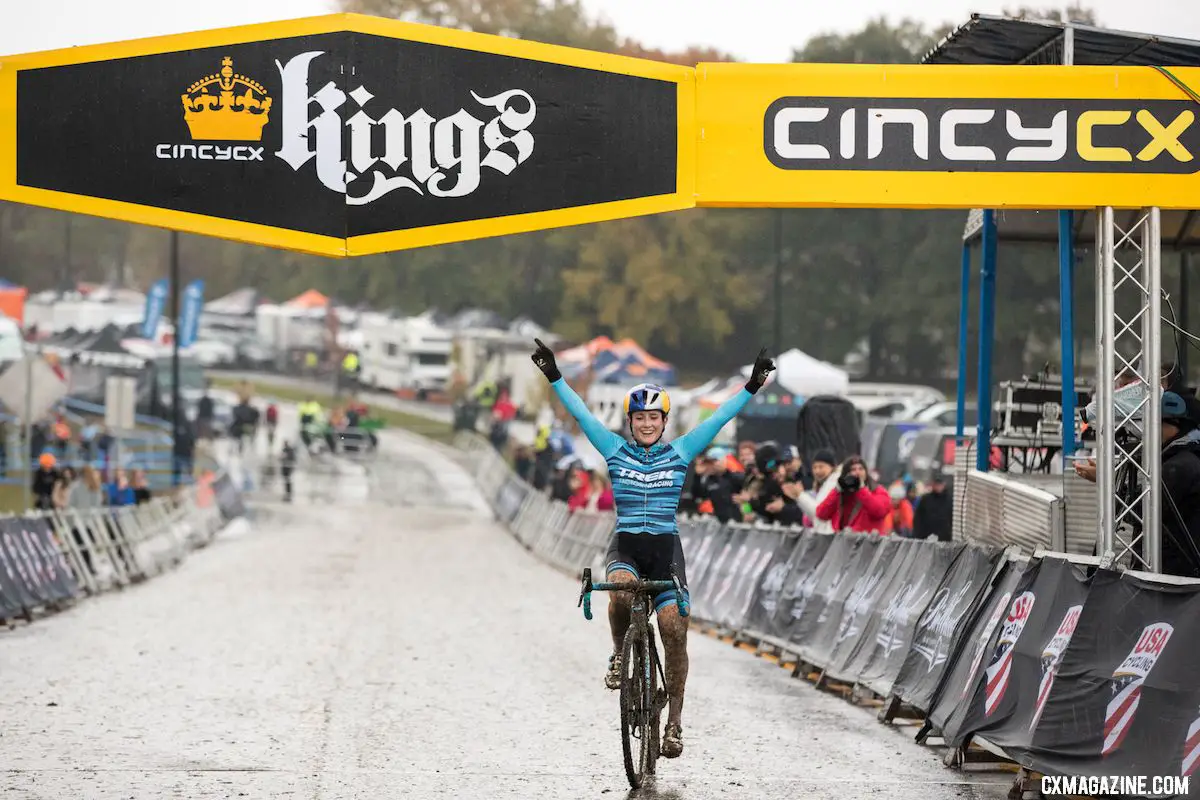
Finish line post-ups are one of those shots you have to get. 2018 Cincinnati UCI Cyclocross Day 1. Elite Women. © Bruce Buckley
CXM: I’m thinking of one that could end up as your answer here, but what is one course that is really challenging and what are some of the factors that made it that way?
BB: Hmmmm. I hate to speak ill of a course that is no longer with us, but I used to have a lot of trouble at CrossVegas. It was really tough. Some years were better than other years. It was pretty packed with people and getting around was difficult. I think in the U.S. we’re pretty spoiled that we don’t have the entire course five-plus people deep. We have really really good access to the courses and to riders that you don’t get in Europe.
CrossVegas was always a little tricky for me to get around. I think I did okay. I would always get some good stuff there, but I always felt like it was a real challenge. Part of it was it also being a night race. That kind of limits your options.
CXM: I was actually going to suggest Reno Nationals. It was so spread out lengthwise and then the one good spot on the hill you had a one-lane pedestrian bridge to get back to reach that section.
BB: I would agree to a point. I had a strategy where I would do have of the course and then blow a lap and cut over to the other half of the course and do that part. That was kind of the best way to do it. There was no going back and forth. You’d go over to the one hill section across the bridge and work all the angles for roughly half the race, and then go back into the grassy, pedally section and do all that stuff. Even there it was hard to get to some of the stuff way in the back. I think there were some steps as well.
I think Hartford Nationals was tough too.
CXM: That course was really strung out as well. There were like two halves.
BB: That was the same kind of concept. It was like I’m going to work this half of the course for half the race and then the other half for the other half. It was kind of a long, drawn-out course. That was a similar challenge.
CXM: Being in the media room, there’s pretty good camaraderie among the folks taking pictures. What are some of the things you’ve learned from your colleagues about your craft?
BB: I don’t think I learn a lot from a photography standpoint from talking to people. I don’t feel like we talk about photography a lot. When we’re there, we just kind of want to be people and talk normally and sit there and talk about work all the time. We’ll just kind of joke around a lot.
We’re all heads down and pretty intensely into our stuff, so while I’m trying to cull through thousands of photos, it’s nice to have people there to kind of joke around with while I’m going through my work. That’s really what I like about that setup. I love the group of photographers we have in our sport. For the most part, its good people who are a lot of fun. It’s a really good group.
In a lot of photography pools, it’s the opposite. It’s kind of like this pool of sharks. Everybody is trying to out-do everyone. Now we are trying to out-do each other, but we don’t do it with jealousy or cruelty. I think we all appreciate that we are talented in our own ways, and I think we can respect that.
But I do really enjoy seeing how other people who shot the same event I shot shot it. I find that fascinating. We have this roughly 3k course we’re all shooting, often from the same spots, but rarely will our photos look exactly the same. It’s really interesting to see how somebody else perceived that moment or that location.
CXM: On race day, what’s the ‘scrum’ we talk about?
BB: The scrum of photographers?
CXM: Yeah. Can you define it?
BB: For me, the scrum is when we’re all at the start line and the World Champion rolls up and 15 photographers are all on top of each other in a scrum trying to get some kind of unique picture of this individual literally just sitting there on their top tube trying to focus on what they’re about to do while they’re just invaded by glass and flashes. That’s what the photo scrum is. We try to be respectful, of course, but we’re working. We have to do our jobs, get out shots. They’re professionals, so they know what they’re doing.
This is the place where you insert that photo from two years ago that Andrew took.
CXM: The one where I was looking at my phone or whatever?
BB: Yeah, that’s the one.
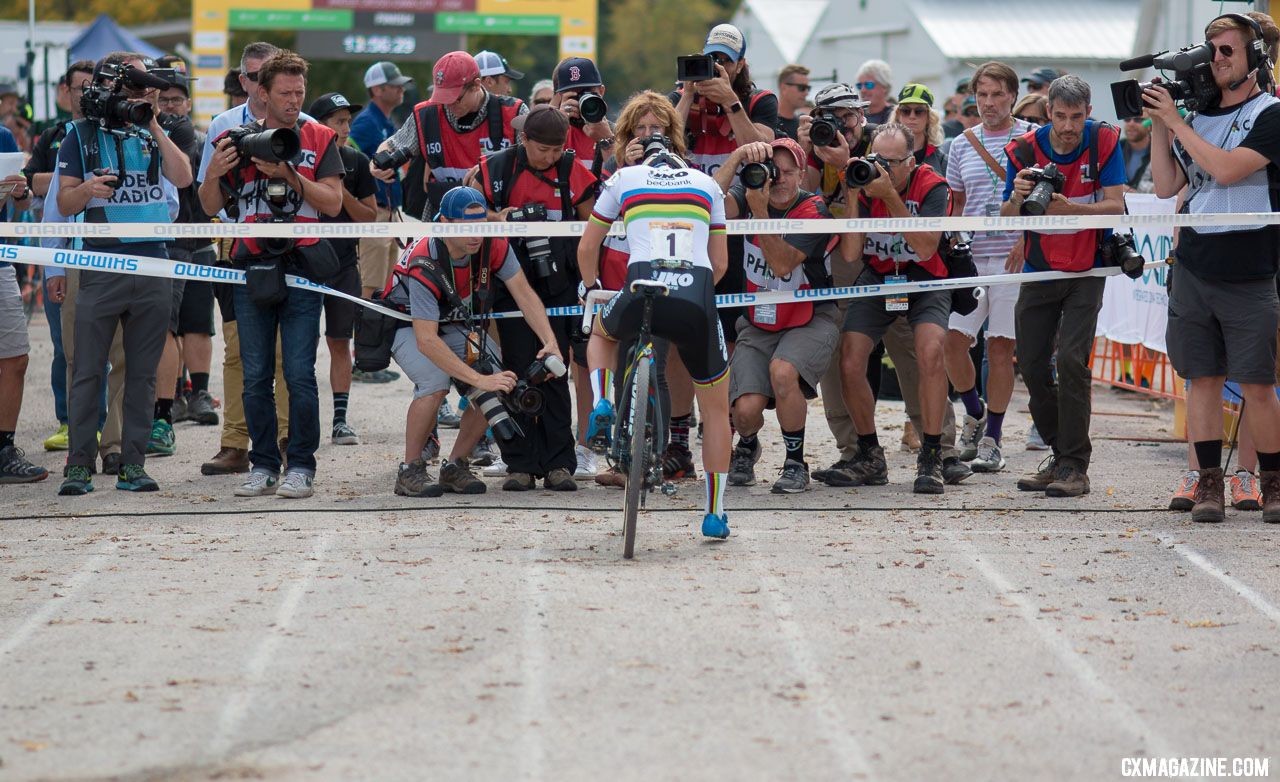
A look inside the “scrum” from Jingle Cross 2017. © A. Yee / Cyclocross Magazine
CXM: I was hoping for a new one last year. Bill was poking so much fun at me.
BB: That’s such a good photo though. The scrum. It’s funny because from the planning standpoint, I remember thinking about this at one of the first CrossVegases I went to. We all shot the start, and we all exited from the same point. We kind of got out and hit what was essentially a tiny opening, and it was amazing to watch as two people went one direction, three people went another direction, one person went off in some direction, we don’t know know why. I went off in another direction with someone else.
I obviously had my logistics plan, but I was thinking, ‘What plan are these guys on? Where are they going?’ What shot are they getting? I was trying to get it out of my head because I had to go to work, but we all walked out as a scrum, but then it exploded in all different directions. People just scurried here and there. It was fascinating to me on some level.
But it was also a bit of that rivalry where I was asking, ‘What’s she shooting? What’s over there? I never even looked over there!’
CXM: You know that was going through your head, ‘Shoot, did I pick the right spot?’
BB: Totally. It was like, ‘Why am I over here? Am I going to mess this up? I think I got this, but now I’m not sure.’
There’s a scrum, but then we all have different plans, so once we get going, we’re all not in the same area. It will be like, ‘Okay, I’m going to the sandpit,’ and three of us will be at the sandpit. But it’s not 15. We’re all following different plans, so we’re not running into each other at each spot.
You get to the finish line, the finish is the next spot where everyone congregates. Officials give us this tiny triangle that we have to try and squeeze our tiny butts into, and we all wish we were Bill Schieken and tall enough where it doesn’t matter where he goes. Then I’m like, ‘Hey, short guy here, you need to put me up front.’
CXM: It has its perks.
BB: Then you have Nathan from SnowyMountain who’s like, ‘Okay, I’m just going to climb a tree. I don’t need to be down there.’ I love those guys from SnowyMountain; they are great people.
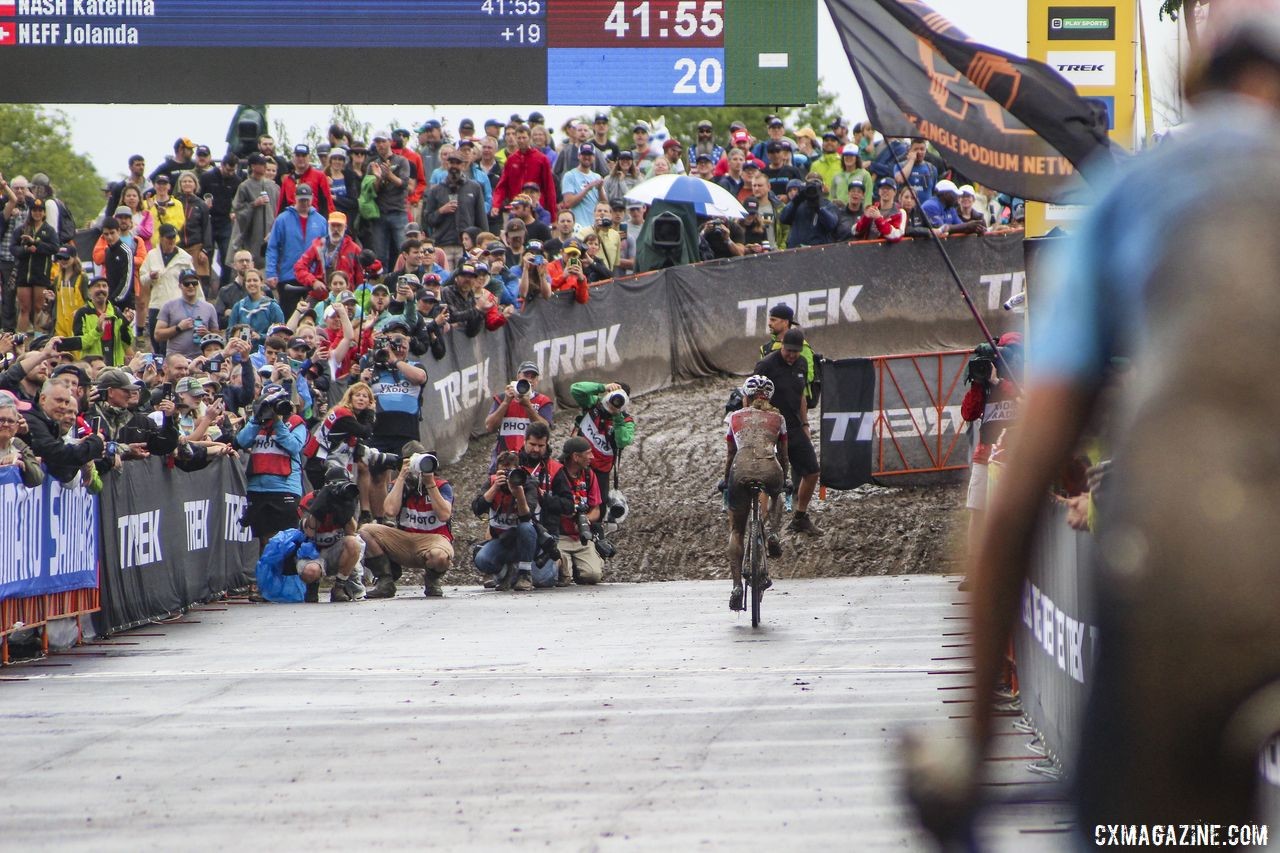
Photographers go every which way after the scrum but end up back at the finish line at the end of the race. © Z. Schuster / Cyclocross Magazine
CXM: So with the plan, you have a lot of stuff going on in cyclocross. Bigger bunches early on, then its more individual riders. Does that affect how you shoot for clients and what they want?
BB: Things do change on a weekly basis, but I’ll say that for the most part, I put together a plan where I say, ‘Where’s the spot where I show how large the field is?’ So how quickly is the field going to split up. I want to see them at least five-wide. Do I only get that at the start? Is there somewhere else where I can see a mass of people? Are there spots that are dusty where I can see a giant plume coming up behind them giving that sensation that it’s a thundering herd coming at me.
Or I think, ‘Okay, where might they be all strung out?’ Is there a spot where there might be 10 or 15 riders in a long row? Where’s the location to do that? Then I start to think about, like you just mentioned, if there’s a group of two or three who are working the front, where’s a good location where I can see all three of them and not just one person with two people hidden behind them.
Then I’m thinking about individual photos because, for example, if you’re shooting for a team, they don’t want to see anybody else in that photo. They just want to see their athlete. So I’m thinking about where I can really isolate a rider, and that’s all I see. As you well know, it spreads out, thins out throughout the race, so the plan goes like that for almost every race on some level. Something similar to that.
CXM: You’re talking about all these things you’re scouting out, and in my position, we certainly know the value of professional photography, but in the modern world, we’ve seen the proliferation of digital cameras and phones and there are any number of photos that come out of any event. How have you managed that transition and managed to stay successful from a business standpoint?
BB: Any kind of event work, it doesn’t have to be sports. Let’s take a wedding as an example. You might have a cousin who has a really nice camera, and you’ve seen some of their photos and they’re really good photos. They might be talented and have a good eye, but do they that as a hobby? Do they do that professionally? Do they do that literally every weekend, twice a weekend? Do they do that during the week?
The reason, in my mind, you hire a professional photographer is it’s a given it’s expected you know how to take a good photo. Basic step one, you can take a good photo. The real important part is can you deliver on key moments when and where they happen every time. You have to nail it. No one’s perfect, you’re going to miss some shots here and there. But a professional will be incredibly consistent and be able to deliver photos on time.
Part of what’s really good and bad, I guess, with our very social-media-driven world we live in now, there’s a need for immediacy. In some ways that’s good for professionals because you do it a lot and you know what you’re doing, the process can go very quickly. You can identify good photos and get them out to people so they have them quickly for social media. They’re processed correctly, and they’re not just something you took directly out of a camera and could probably use some work.
A lot of people can get really good at processing photos, but what we do, there’s no time for that. You need to be able to shoot a good frame that looks like it’s at least 80% there out of the camera because there’s just no time in this world to open Photoshop and start manipulating images. There’s just no time for that.
If I can’t do those things, if I am unable to deliver and perform at a higher level than someone who’s a hobbyist, then you shouldn’t hire me. If you want to be a professional, you have to put out better than average photos, and hopefully exceptional photos. Otherwise, why would people give you money for it?
CXM: In my opinion, in cyclocross I think we can look at the social media accounts of teams that are hiring professionals and see the quality of their images. To me, it’s a no brainer to do that versus trying to piece together images every week.
BB: Look, not everybody cares. There are a lot of people out there who just want a photo. They just want something to prove they were there. A lot of amateurs are like that. I find that a lot when I’m shooting amateurs. They just want something that says, ‘Hey, I was at this thing and I want a picture for Facebook.’
But I think when you’re shooting for pros, they recognize this is marketing. This is about really trying to convey something about what you just accomplished. So you want to get, I hope, a professional photographer to do that for you.
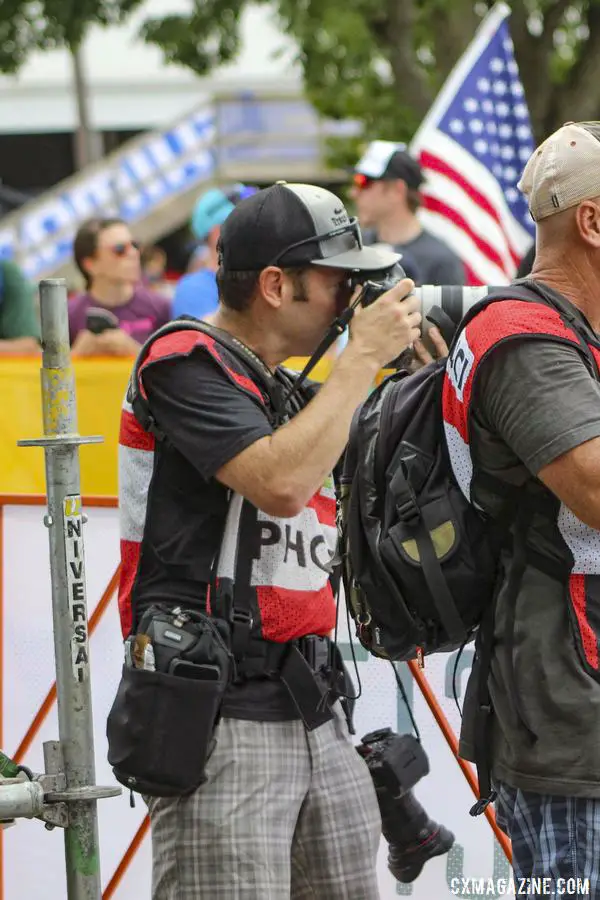
Bruce Buckley shoots the finish of the 2019 Jingle Cross World Cup. © Z. Schuster / Cyclocross Magazine
CXM: As a photographer, you run around, personally we chatted about you getting into shape for cyclocross season, you’re probably pretty svelte by now, but when the races end, you’re not done. You’ve shot the podiums, you’ve done your thing. I got to see some of this when I’ve been in the CXHairs media headquarters. When you leave the venue, what does the rest of the night look like for you?
BB: You know, it’s just a bottle of whiskey and throw on some jams. Come on now. Really the hardest part of the day for us is when the races are over because you’re exhausted, and you are now under deadline. That’s really hard. It’s the part that nobody sees, and it’s the hardest part because of what I said. You are fatigued, you want to stop, and you cannot. You have been going for a very long time. We’re all somewhat amped from being in that race situation, and you want to come down from that, but you can’t. Once you let it go, you’re really going to struggle.
So what do I do? I look at my plan and the first thing I do is think about my shot lists and delivery schedule. Obviously, first thing, I’m uploading all my images to a hard drive so I have them saved. Then I’m poring through all the images I shot looking for the ones I need or maybe ones I really like. Mostly it’s about need. What really needs to be processed right now.
Normally I have a priority list in terms of what images need to be delivered when. If it’s an editorial client, those finish line photos or podium photos or maybe some in-race highlights, those have to go out like ASAP. That’s news, get that out immediately. I might even wifi those right off my camera.
Now let’s say a client from a team or something go on the podium or won the race; well, they’re going to want images ASAP as well. That’s an expectation. I basically just go through everything after the race and getting as much done as possible.
I mentioned wifi. Sometimes I need to provide images while the races or events are going on. That requires me to stop, get an image onto my phone and shoot it off to a client in as real time as possible.
The other thing is I really want to get as much of it done as I can because I don’t want to be carrying a backlog into the next day. That’s just going to make it hurt even more once the race is over on Sunday. Then it’s like, ‘Cool, now I have all of the stuff to do from Day 1 in addition to Day 2.’ I don’t want to carry that load over if at all possible.
I should also mention one of the biggest x-factors is quality wifi.
CXM: You’re not wrong. You are not wrong.
BB: I think you know this as well.
CXM: Oh, I know all too well.
BB: If possible, I try to figure out as far in advance as possible where I can get strong wifi because the quality of wifi is often the difference between getting to sleep at a decent hour or staying up all night.
CXM: I think Thom Parsons from DirtWire has it dialed which Starbucks stay open late in the towns races take place. I would say Starbucks is a gold standard, but they usually close at like 8 or 9 p.m., which doesn’t do us any good.
BB: Yeah, I worked with Thom at Transylvania Epic this year, and we both had similar goals. It was awesome because I knew Thom would find a place. I never had to invest any effort into it. He came to me at some point and was like, ‘Yeah, they have this Starbucks and it closes at 8, but I found this pizza place that supposedly has really strong wifi, and it has a bar, so it will be open really late. The pizza place might close, but the bar will be open late so we can stay there as long as we need to.’
So we at this pizza place and we just sat at the bar and did our work for a good chunk of the night.
I have to say, I’ve found several Media Centers at truck stops on interstates. They’re like some kind of magic portal. You don’t quite know where they’re going to be, but then you find them. It’s a vortex that actually allows me to ship my photos off.
CXM: At Nationals, we end up going to the same place every night. They’re like, ‘You’re here again?’ It’s like, look, we’re not messing with something that works.
BB: Exactly. It’s such a huge thing for what we do.
So let’s say on Day 2 of an event, I try to get to the venue as early as I can, particularly in the course has changed from Day 1. You usually don’t see both configurations. When you go the night before Day 1, you’re going to see the setup for Day 1. They’re not going to have it set up for Day 2.
Now if it’s a totally different configuration, now I have to go scout again and put together a new plan. Sometimes they don’t change it, so I think about what I can do to improve on what I did on Day 1 or find new locations to try. I don’t want to repeat what I did the day before.
Once it’s race time, the basic plan pretty much goes the same, but at the end of the day, it’s an even harder push on Day 2. We’re even more tired at this point. We probably didn’t get enough sleep Saturday night, and I probably have some amount of backlog I didn’t get to on Day 1, so I’m deep in the hole and I’m trying to push through the night after Day 2.
CXM: Then Monday is the biggest social media day of the week, so you don’t want to be late delivering stuff for Monday.
BB: No, exactly. And I’ll know schedules. Sometimes a client will say, ‘Get it to us by noon because we’ll be traveling.’ They set the expectations about when they expect to have stuff. Sometimes people will say, ‘Don’t worry, anytime on Monday is good.’ Then I’m like, great, I can work with that. Then some are like, ‘Hey, I want this Monday morning when I wake up.’ Then I have to work on it the night before.
Monday, I finish up whatever I need to do. I might have sent things out piecemeal to a client, but then I’ll package it all up and send it when I have time. Once I kind of clear that out, then I’ll try to find time to do my own social media if I can just to kind of say, ‘Hey, I was here.’ It also allows me to give my own observations from the event and put my own voice to what I do.
Then as the week goes on, I quite often get additional requests for images. People will say, ‘Hey, I saw you were there!’ So then I work on getting those requests done. Sometimes I’ll have things like a Big Picture piece for CXHairs. Those are sort of like the photographer’s perspective on everything with some of my favorite shots.
That is one weekend. That is one weekend Zach.
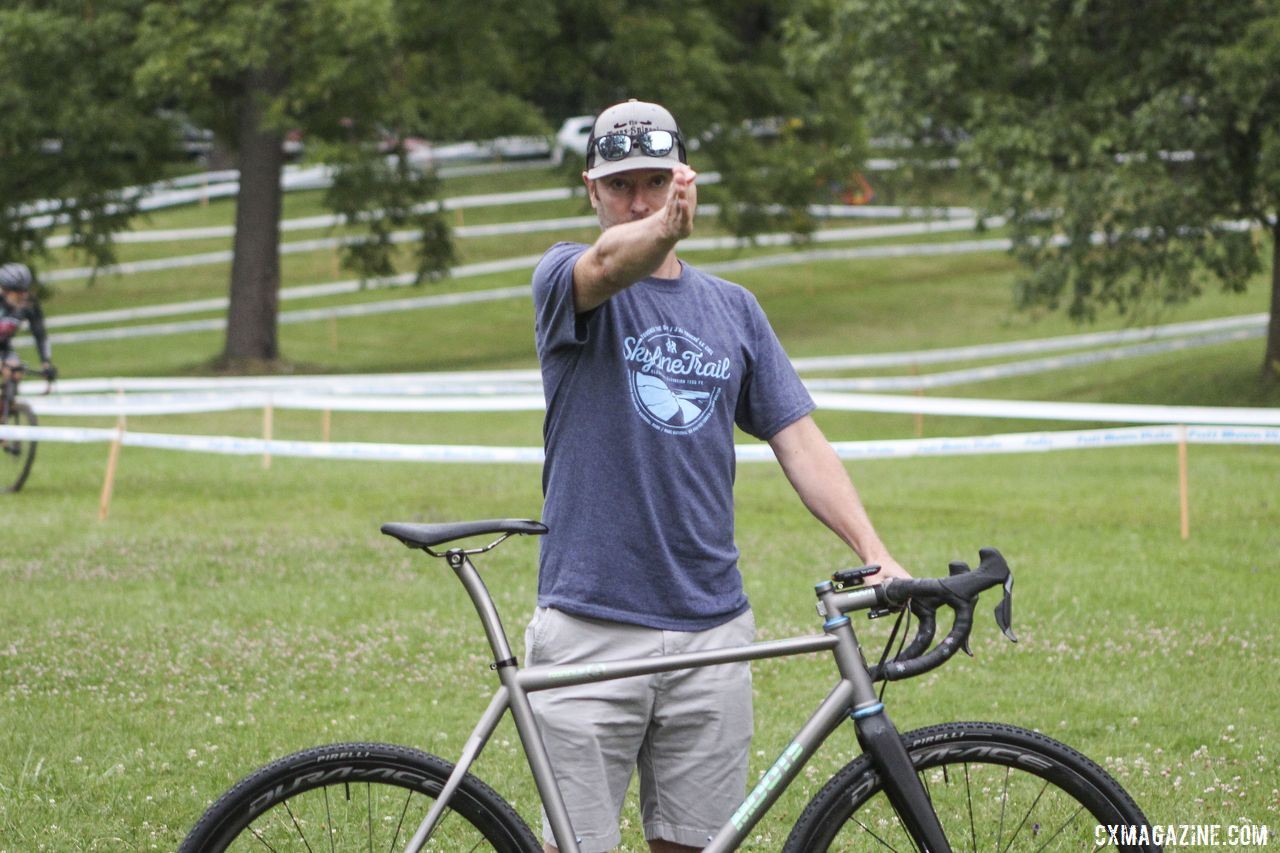
Client work, including helping shoot team bikes, is a regular part of Buckley’s work. © Z. Schuster / Cyclocross Magazine
CXM: Your clients get their money’s worth from the work you do many. I respect the shit out of how hard you work and the level of professionalism you put into your job.
Changing gears, equipment-wise, you shoot Canon, if I’m not mistaken. How long have you chosen Canon and why?
BB: I‘ve shot Canon ever since I switched over to digital. At the time when I switched to digital, Canon was unmatched for sports. Eventually, Nikon caught up, and they’re all great now.
Equipment doesn’t really matter a lot to me. Reliability and durability are extremely important to me. Certain things are important to me that might not be as important to other people, and those things kind of dictate why I make certain choices.
I think people put too much emphasis on equipment stuff. As Chase Jarvis says, ‘The best the camera is the one that’s with you.’ Something like that. The best camera you have is the one with you. Whether it’s your phone or a point-and-shoot, if you don’t have your awesome, awesome $10,000 camera gear with you, you can’t take a photo with it. You have to take a photo with whatever you have.
I don’t want to belittle those choices, but I think a lot of people spend a lot of time on equipment. I need it to be super durable. You’ve probably seen my stuff, it’s pretty banged up. But it is also maintained professionally by Canon and it functions perfectly, which is why I like using it. It can take a beating and still deliver high-quality images with no degradation.
CXM: One thing I love about cyclocross, there are so many opportunities to be creative. Where you sit, how you sit. You can shoot it long with a zoom lens, you can shoot it wide up close. You had some real bangers you shot recently with your wide lens. How do you mix those approaches? What’s your favorite? Do you plan out how you will shoot a race?
BB: I think I have a few looks that I’ve probably settled into, but I try to not allow that to happen. I don’t want to get predictable. It’s funny because people say, ‘You have to develop your own look.’ I don’t want my pictures to always look the same. I want to explore different things.
Focal lengths are a really good way to do that. For me, it’s really just about a feeling that the photograph is going to convey. Like does it feel big? Does it feel intimate? Does it feel like you have really zoomed in on that rider and you just see what they’re going through right now? Does it show how massive the event is? Like here’s the rider, and look at all of this chaos around them. Or look at this insane feature they’re trying to get over. Or all these spectators around them.
I think about it like a cyclist, and I think this is where being a cyclist helps me and other cycling photographers. We know some of those feelings, and we tap into those and try to find the look that matches those feelings.
CXM: If someone is interested in photographing cycling or specifically cyclocross, what should they do? Like I remember last year, we published a gallery a kid shot at Rochester that was pretty good.
BB: That kid had some talent!
CXM: So what do you recommend for someone like him. Journalism school, but maybe not?
BB: This has nothing to do with cyclocross necessarily, but I often hear, ‘Hey, I want to be a photographer, what camera should I get?’ I tell them, ‘Don’t worry about what camera you should get, you should worry about learning about how to have a discussion between you and your camera.’ I highly recommend that people take classes.
Now you don’t have to go get a degree. You can go to your community college and take a photo class or two for a decent community college price. You know who are the professors at those community colleges? Working professional photographers, quite often. What you will get from that is something you will not get anywhere else, which is honest, constructive feedback of your work. They’ll look at your photos and tell you what’s working and what is not working and offer constructive advice.
You need to learn how to have that dialogue. Your camera needs to be an extension of yourself and your vision to become a communication tool. You need to learn how to speak the language. You could drop yourself into a foreign country and eventually pick up the language, but maybe you should take some classes on how to speak the language. I dunno.
Then, of course, you go to a foreign country and you realize, wow, this is way beyond anything I learned in class. Then you get to the next level, which is just go to races. Take the camera. You know how to use it, now just go out and find your own vision. Just shoot a lot. Shoot whatever you want.
Just today, I had somebody ask me, ‘Hey, I’d like to pick up some client work.’ I couldn’t help them with that, but I told them, ‘Just go to this race anyway. Just go to that race and shoot it.’ If you don’t have any other things going on, and you want to get better at what you’re doing, here’s a great opportunity. Not having a client might be an advantage because you can shoot literally whatever you want. There are no restrictions, no requirements. You can shoot anything.
You just shoot, and then go home and say, ’50 of these suck, but 5 of them I really like.’ Then you ask, ‘Why do I like these 5 photos?’ Then you start to really understand why you like certain things. Then you go out and 40 photos suck and 10 don’t, and then it just goes from there. You have to put in the work. You don’t think that just buying a really good camera is going to do it. You put in the work and it will all come back to you.
CXM: Dude, thanks so much for your time. This has been a blast.
BB: Thanks. Enjoyed it as well.






















